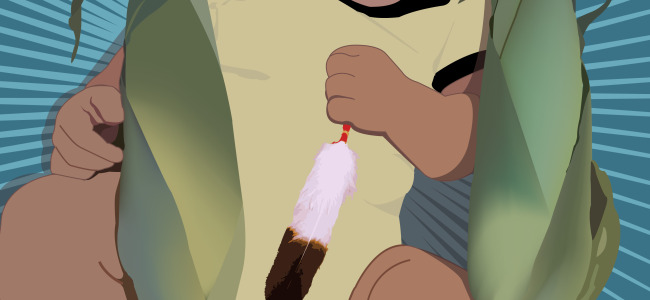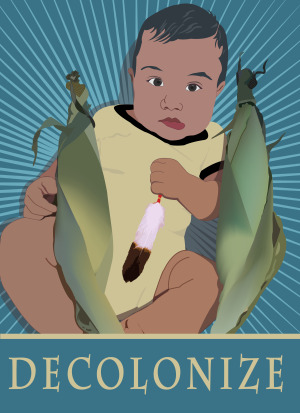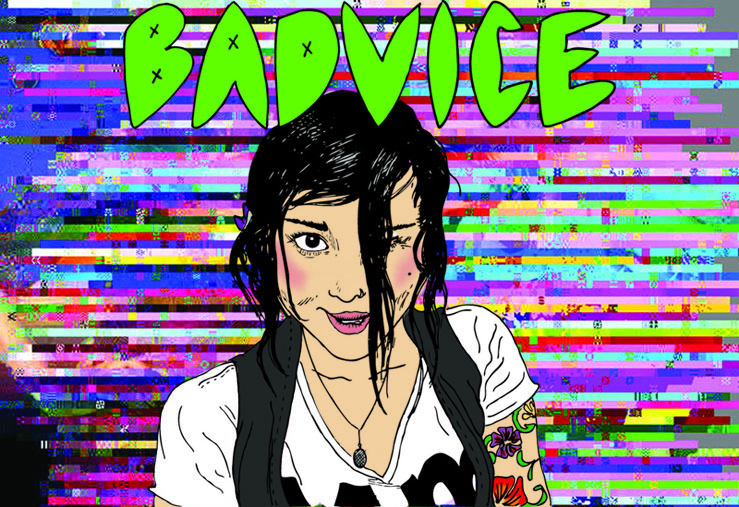
Seven Generations past 1491: Reflections of a Concrete NDN

by Jennifer Fox Bennett
Art by Monica Villarreal
There was no darkness in the beginning.
In most North American indigenous cosmologies, the universe did not evolve from a void. There was no “beginning,” per se. Or maybe there was, maybe there wasn’t. We are not really interested in it, or we have no way of knowing. Where our stories begin is when this universe metamorphosed from a previous manifestation. The dozens of nations that lived in the Eastern Woodlands areas, post-Cahokia, pre-Columbus, believed that the universe as modern humans know it, was a world of water. Immense water. Depending on who you ask of Algonquian- and Iroquoian-speaking peoples, great sacrifices were made by members of the animal kingdom who dove to the bottom of the ocean to bring up dirt, from which the Creator made North America. Lowly muskrat was our successful hero in one of these beginning stories. Humans owe this humble creature the dry land on which we live and thrive. People in the Southwest, descendants of Anasazi, believe something completely different — the world began with the land already here. Humans emerged from a great, lower world. Moreover, there is room for both of these stories to be true. There is even room in these cosmologies for the universe to have begun from a void or a Big Bang.
Related to this theme of transformation is the idea that the universe is comprised of interconnected spirits and beings with independent “souls.” In my language, nouns have two genders, but unlike Romance languages, they are not male and female, they are animate and inanimate. Things that are animate have a spiritual force: animals, clocks, pictures, but not household items like mattresses and rocking chairs. More examples of animate things that Judeo-Christian beliefs do not hold as such are things like the sun, the moon, the Northern Lights, the stars, animals, and corn, but not turnips or carrots. I digress. The universe is complicated. Some things have spirits, others don’t.
When talking about my (First) nation, or other nations of this hemisphere, I don’t use the phrase Pre-Columbus or Post-Columbus. I don’t use the phrase “tribe.” The word “tribe” negates the fact that we were various forms of geo-political nation states. Each nation spoke its own language and had its own religion. It also feeds the false presumption that North America was an empty wilderness—that we were a stagnant, Cro-Magnon group of uncivilized hunter-gatherers.
Charles Mann, a journalist, wrote a book, “1491,” which expounds on newer archeological evidence that debunks the Colonial and Post-Colonial belief that only a few million people inhabited North America before Columbus landed. On top of the evidence that people were here before the Bering Land Bridge theory, he lists a number of reasons and first-hand European accounts that corroborate the existence of a far larger population in the tens of millions.
I don’t use “Pre-Columbus,” I use the more colloquial “back in the day” to differentiate our lifestyles, not because our civilizations suddenly began or stopped with Columbus’ arrival. It is to denote that we are on a different trajectory than the one we used to be on. In the previous trajectory, two cradles of civilization invented farming methods: one in Peru, and one in Mexico. In the previous trajectory, complicated Meso-American religions were brought north, with farming methods, and corn. Meso-America brought pyramid-building to the Mississippi River valley people over a thousand years ago, which culminated in great engineering feats of mound-building that mastered the magical, interrelated geotechnical properties of clay and silt and sand and bricklaying sometime around 1,000 A.D. Another ancient group of ancestors of the people of the Northwest Coast mastered an understanding of surficial wave energy dissipation and designed and built dynamic skeletons for the body of personalized sea-faring vessels known as kayaks. And yet another practiced large-scale forestry care by setting managed burns of undergrowth. And yet another, my own, who mastered one of the largest natural highway systems in the hemisphere, the Atlantic watershed, with canoes, collecting decorative goods from an ocean a thousand miles east, and trading their own local copper a thousand miles south.
Columbus arrived. Another transformation occurred. It was dark. It was bloody. There is a lot to be said about the man, as an individual, and about his and his crew’s immediate interactions in the first several months after his arrival. Their legacy is the devastation of Hispaniola within three short decades.
It was a long, black, hopeless nightmare for several generations after.

I imagine that he will grow up enjoying action movies like his Dad and I will explain to him that the post-apocalyptic, pop-culture favorites of his father, “Mad Max,” “Waterworld,” “Tank Girl (ok, that’s mine),” “The Book of Eli,” and my teenage pop-cult book favorites like “The Stand” and “Swan Song,” are modern versions of what happened to many, many First Nations on these continents.
Mann dedicates chapters of 1491 to the arguments in academia over the calculation of Pre-Columbian population numbers of the Western Hemisphere. The biggest, nightmarish take-away is imagining the densely-occupied urban centers of Pre-Columbus North and South American societies suffering wave, after wave, after wave, after deadly wave of horrifying, disfiguring, and painful diseases. He explains just how large villages and cities actually were — the largest, Tenochtitlan (modern-day Mexico City), was estimated at 250,000 at its peak in 1491. Villages from Massachusetts to Virginia to Mexican States down into Peru were wiped out, in numbers in the 90th percentile, where 9 out of every 10 people died.
“The Book of Eli” is predicated on the humble act of rebuilding civilization with the scraps of humanity’s greatest and most precious achievements of knowledge. Spaniards, in the decades after the conquest of Tenochtitlan, burned libraries of the Aztecs, Teotihuacanos and Mayans in other cities they ravaged. Many people north of the Rio Grande did not use a 2-dimensional writing system, but kept stories with special individuals and respected elders. Imagine the pain of losing 9 in 10 Americans and trying to rebuild the Library of Congress from memory. What’s even more harrowing, is that it was just the beginning of more nightmares.
Within decades of the Declaration of Independence being written, several nations of the Southeast United States were removed by force by the U.S. military. Uprooted, forced to march in cold extremes, sleep under the sky with no shelter through rainstorms and snow, they had to watch babies and children and aunts and uncles die from exposure, or waste away under government rations of flour, lard, and coffee beans. But, like all aspects of the universe, as the sun returns every dawn, night transforms into day. The vital world that once contained rivers of buffalo and grizzlies that once roamed the trees beneath Lake Tahoe ski lifts transformed. As did, too, the world of Hotchkiss guns and wars with the U.S. Army; and Indian boarding schools, the century-long experiment crafted by a retired Army officer to forcibly assimilate generations of Native children, also renown for hiding pervasive physical and sexual abuse behind closed doors. And, the world of reservations, alcohol dependence, Type 2 diabetes, and suicides. Our people believed, though, that there would eventually be an end to these wars of many fronts. Our cyclical existence guaranteed the transformations of these previous worlds. A symbolic Seventh Generation of “new people” would emerge and bring hope and pride and positive life-ways back.
A light was shed with the American Indian Movement in the late 60s. It brought back a long lost warrior culture — not to be confused with machismo. Around that same time N. Scott Momaday wrote a Pulitzer Prize winning novel, Dee Brown wrote the seminal “Bury My Heart At Wounded Knee, and Vine Deloria, Jr. wrote “Custer Died For Your Sins.” A couple of decades later, “Smoke Signals” hit the big screen. It was massive. But it still pitted Indians on reservations, requiring passports to navigate the foreign world of off-Rez life. The truth is, most federally-recognized Native people in both the U.S. and Canada do not live on a reservation.
When “Smoke Signals” came out, I had friends in nursing school in Toronto. I was in an engineering program at Cornell University. The American Indian Program would host a traditional Iroquois (Haudenosaunee) social where we’d dance to traditional songs. Later on in the summer, I might go to a music festival and see the roaring blues band, Indigenous, who are Nakotas from South Dakota, or the punk band, BlackFire, who are Navajos from Arizona, respectively.
A few years later, when I moved to the San Francisco Bay Area, I started a blog. I discovered another handful of Native bloggers doing the same. I got caught up in the spoken word and literary scene there. I eventually joined the local roller derby league when the modern version of the sport was just starting to take form. I skated under the moniker Windigo, #1491. Thanks to their training and my own, I earned a coveted spot on Team Canada to skate in the inaugural Roller Derby World Cup in Toronto in 2024, placing silver in the tournament.
I wasn’t the only one living the life of a Concrete Indian. I joined a proto-Facebook created by a Native guy from the Garden River Reserve in Ontario. It put me in touch with all kinds of movers and shakers in reservation communities, or other off-Rez Natives, like myself. I met a Kiowa in San Francisco who made electronic dance music in a studio he built with money from working as a programmer for “Finding Nemo.” I met a young Native guy of many different nations who had just graduated from the Institute of American Indian Arts with a B.A. in photography. He later went on to be a leader of Native wellness as a board member of the Native Wellness Institute promoting a decolonized diet that he dubs “Native paleo.” (He also self-produced a video for the annual Rock Your Mocs campaign encouraging Native people to be proud of their culture and wear their traditional moccasins to work which is on YouTube here.) I met other Natives online who were writers, photographers, musicians, emcees, comedians like the 1491s, and graphic designers. We are thriving, in our own way, bringing our culture with us.
The truth is, in addition to living a full life in the living culture of the U.S. and Canada, we never forget the history that got us to this point and the work our ancestors had to accomplish to thrive in the face of the historical legacies of apocalypses, wars, and social illnesses. My son is on this second trajectory. It is my job to teach him the stories of both trajectories and what our ancestors did, as muskrat did, out of love for us, so we can thrive.


You must be logged in to post a comment Login